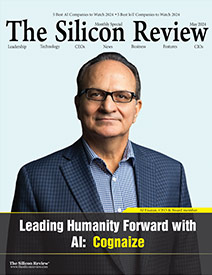A pioneer in creating and developing a simple, innovative, non-invasive eye scanning test to aid in the early detection and diagnosis of Alzheimer’s Disease: Cognoptix
The Silicon Review
![]()
Technological innovations are continuing to drive the growth of the healthcare sector, leading to breakthrough technologies that play a critical role in solving long-standing problems in the medical field. Even with all the latest advancements, diagnosis for Alzheimer’s disease has remained a challenge with no reliable tools or methods for large screening and early detection. This has led to unnecessarily later stage progression of the disease and much higher costs of care. Often the disease is diagnosed only by observing behavior changes or by using memory tests. It is important to understand that by the time that visible symptoms appear, the disease is in an advanced, likely irreversible, stage. We urgently need an inexpensive and non-invasive way to detect Alzheimer’s disease earlier.
Various healthcare researchers and companies are trying to innovate new methods to diagnose Alzheimer’s, but Cognoptix stands out from the rest with its Sapphire II system, detecting Alzheimer’s disease through a simple scan of the lens of the eye. The key to effective, preventive therapy and treatment of Alzheimer’s is through the creation of an “early warning system” for the disease before it progresses to the point where treatment options are limited. Cognoptix’s technology has demonstrated successful preclinical and clinical results as the company develops its diagnostic platform, consisting of a laser eye scanning device combined with an ophthalmic ointment to specifically identify Alzheimer’s-related proteins found in the lens of the eye. Cognoptix is based in Marlborough, Massachusetts.
In conversation with Susanne Wilke, President and CEO of Cognoptix
Q. Tell us in brief about the benefits of your non-invasive eye scanning test, the Sapphire II.
With the anticipated approval for early Alzheimer’s disease modifying therapies, the heightened need for an early diagnostic tool is of utmost importance. Cognoptix’ Sapphire II may have the potential, once approved, to play a major force in matching patients with amyloid accumulation to disease-modifying treatments once approved. Ultimately this diagnostic test could change the course of Alzheimer’s disease entirely.
Therefore, we need easily available, non-invasive diagnostic tools like Cognoptix’ Sapphire II system to aid the detection of Alzheimer’s at the earliest possible point, much earlier than can be done easily today. None of the other diagnostic tools currently used can be performed as routinely or easily. The available tools are much more invasive, less accessible, and expensive, making them out of reach for most patients. It is of no surprise that only roughly 3% of patients are currently diagnosed for their amyloid status in the brain despite growing numbers of patients in need. If these tools could be made more broadly available, 100% of patients being at risk or suffering from cognitive decline would have the ability to be tested. There has been significant scientific development of Alzheimer’s disease, highlighting a number of key insights over the past 10 years. All of these newer insights have heightened the need for earlier detection in a patient population that is younger in age, in their 50’s and 60’s, who may be less suspecting of the risks of developing Alzheimer’s disease. To better engage these patients, we need non-invasive, more affordable tools like Sapphire II for earlier amyloid-detection.
Q. Generally, diseases are detected and diagnosed by professional and trained technicians. How does your solution align with the existing medical practice?
The current gold standard of Alzheimer’s diagnosis is considered to be the amyloid PET scan. However, amyloid PET has significant shortcomings that dramatically limit its accessibility with only an estimated 3% of patients receiving a PET diagnostic test. The amyloid PET diagnosis is most accurate for more advanced patients, but any therapeutic impact is reduced at that stage as advanced neuronal damage is not easily reversed. For earlier-stage Alzheimer’s patients, a dual read of the amyloid PET scan is useful at extra cost.
The Sapphire II meets all the market needs and directly overcomes the drawbacks of the amyloid PET procedure. As an office-based system, the Sapphire II is poised to![]() become widely available for testing after its FDA approval. It would be used in professional offices like neurology, primary care, and ophthalmology, or other accessible places like imaging centers. With its high accessibility, unparalleled safety, non-invasiveness, and cost at only 1/20th of an amyloid PET scan, the Sapphire II system will overcome the drawbacks of this gold standard detection platform. Notably, the Sapphire II can be operated by technicians with its user-friendly interface. Most importantly, the Sapphire II can handle a large number of patients and is not limited by high-cost components or super high-tech mass spec procedures like blood tests, likely limiting those tests to more academic centers. Favorably, the Sapphire II also has a high likelihood of being reimbursed given its cost savings, enabling the right patients to be matched with treatment.
become widely available for testing after its FDA approval. It would be used in professional offices like neurology, primary care, and ophthalmology, or other accessible places like imaging centers. With its high accessibility, unparalleled safety, non-invasiveness, and cost at only 1/20th of an amyloid PET scan, the Sapphire II system will overcome the drawbacks of this gold standard detection platform. Notably, the Sapphire II can be operated by technicians with its user-friendly interface. Most importantly, the Sapphire II can handle a large number of patients and is not limited by high-cost components or super high-tech mass spec procedures like blood tests, likely limiting those tests to more academic centers. Favorably, the Sapphire II also has a high likelihood of being reimbursed given its cost savings, enabling the right patients to be matched with treatment.
Q. What are the challenges you had to face while developing your solutions? How did you overcome them?
The Sapphire II instrument is a breakthrough, superior technology developed by Cognoptix. The original discovery came out of research at Harvard University using the same-patient eye lens and brain autopsy studies. The team determined quite remarkably that the lens produces its own amyloid in accordance with neurodegenerative processes in the brain, a standout discovery for the field. While detecting amyloid in a fixed PET scan during an autopsy is relatively easy, detecting amyloid in a moving biomolecule such as a moving lens or in blinking eyes of living patients provides a higher hurdle to overcome. For this reason, it took a number of years of technology development and fine-tuning. The breakthrough came in 2012 and then again in 2019. We established a large, competitive patent portfolio of 42 issued patents and developed a system using a ligand and high-frequency fluorescent eye scanner to capture a unique signal with an excellent signal-to-noise ratio. What is now a very elegant, easy to use system and a solution to a vexing problem was a long time in the making! We are very pleased with the Sapphire II system in its current form.
Q. Tell us about the different applications for your technology and how it is different from the existing diagnostic practices.
The system is highly targeted to take Alzheimer’s diagnosis mainstream and enable more awareness for a much earlier disease diagnosis. As described earlier, the current technologies are unable to fill this need or only at exorbitant cost to the healthcare system, which in turn is quite limiting to broader access by patients. Even most technologies currently in development are not suitable to allow such broad accessibility of diagnostic tool. The limitations of current diagnostic tools pose a significant unmet medical need to patient care, which will be largely exacerbated by the upcoming disease-modifying class of therapies aimed to specifically target the removal of beta-amyloid. The near-term availability of these disease modifying therapies represents a momentous breakthrough for the Alzheimer’s research sector and will require a dramatically new way for amyloid-detecting therapies to be matched with the right patients. Importantly, the FDA is highly likely to require a positive amyloid test to be done to identify these patients for treatment. A likely example is the approval of Biogen’s Aducanumab, possibly later this year, to be the first disease-modifying therapy on the market. The industry is not currently equipped to perform the additional hundreds of thousands of hospital-based diagnostic tests for amyloid positivity, presenting possible limitations in the uptake of these newly and highly anticipated therapeutics. This is where the Sapphire II will come in. The Sapphire II system will ultimately be available in several applications for short and long-acting amyloid-binding ligands and also will ultimately have a tau test available in the future iterations.
Q. According to you, what are the top three skills to become a successful business leader?
As an entrepreneur and CEO of an innovation-driven biotech company, one needs to (1) Be well versed in the science, clinical research and commercial factors; (2) Be comfortable working in a very fluid environment with many moving parts and competitive forces; (3) Be highly focused on the success of one’s own company and understand the truly differentiating attributes of one’s own product.
Q. What would you say is the single most influential factor of your business’ success?
A strong team. Cognoptix has an awesome team with a lot of dedicated experts who believe in the success of the company. It makes it easier to work when everybody is rooting for the success of the team and company and is motivated to make a real difference in people’s lives.
Q. What does the future hold for Cognoptix and its customers? Are exciting things on the way?
The Sapphire II system will help facilitate that Alzheimer’s diagnosis, not just because of it much lower cost to patients, physicians and the healthcare system at large but also because the Sapphire II will make diagnosis much more accessible and mainstream to patients. The Sapphire II system will help to create more awareness for Alzheimer’s disease and allow for earlier detection and subsequent treatment. Delaying the onset of the disease by 5 years is estimated to delay the overall progression of the disease by 50% downstream. Earlier diagnosis can help tremendously here.
This device/drug combination system may help change how patients look at Alzheimer’s disease, not as an inevitable fate but instead something that can be managed and treated. Alzheimer’s patients overwhelmingly state that they wish they had known earlier and had time to prepare for the future before their cognitive facilities started to decline. This is a particularly frustrating reality since we now know that Alzheimer’s disease starts much earlier, 20-30 years, than routinely detected clinically. We are trying to change the narrative for the patients, create awareness of their individual risks of developing the disease, and allow them to take more control of their brain health and aging process.









